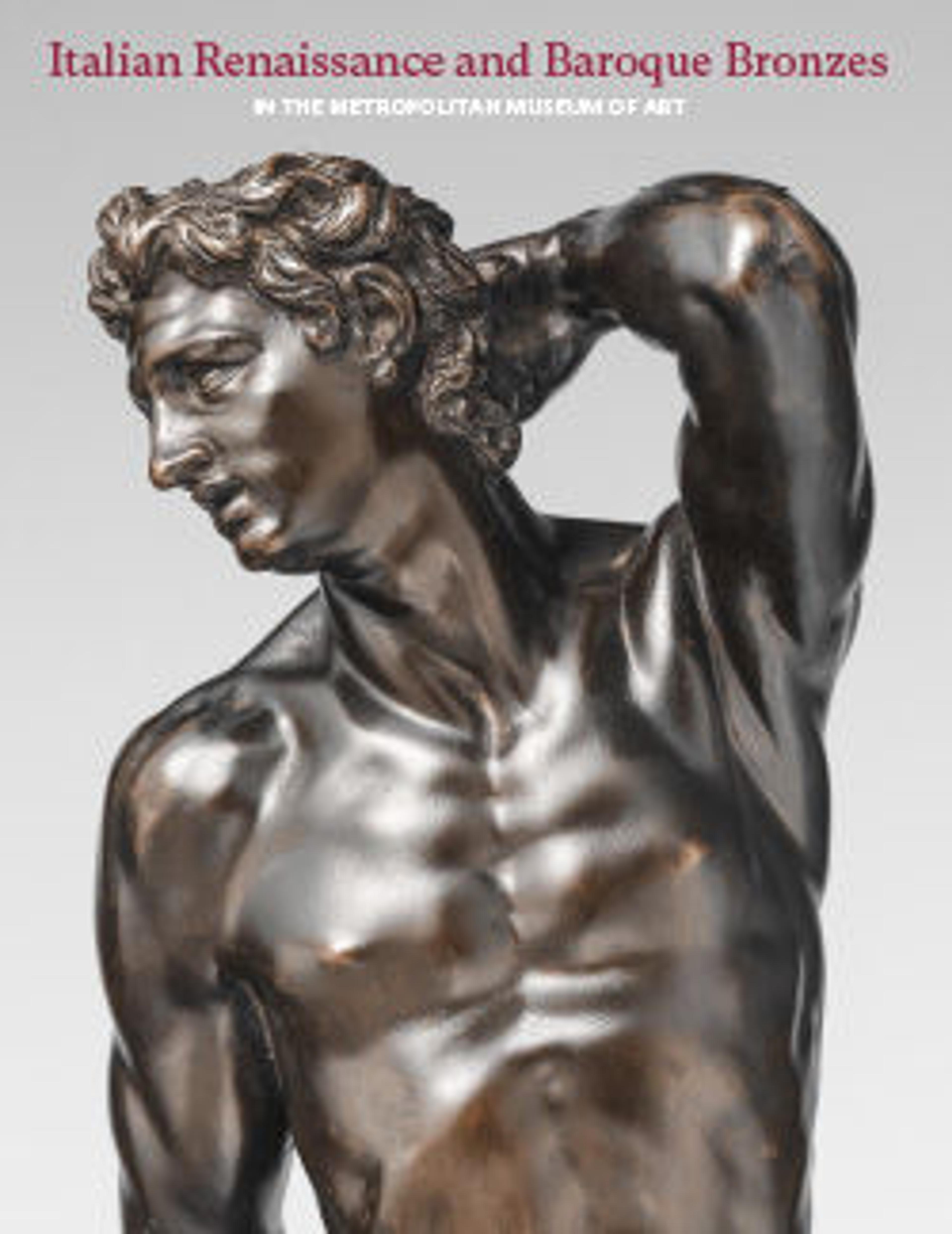Angel (one of a pair)
The angels, of a brassy metal, show well-preserved mercury gilding, burnishing, and some corrosion and rubbing. A faithful affirmation of quattrocento standards of modeling, as in the works of Antonio Pollaiuolo, Andrea del Verrocchio, Benedetto da Maiano, and their many emulators, is clear. The costumes, with ample peplums, rolled-back sleeves, and skirts curling up at the ankles, also exhibit a thorough understanding of current imagery. It is a favorable sign that the features and hairstyles do not match: the right-hand angel, with a longer, oval face, wears a finely faceted bandeau on his forehead. It may seem surprising in terms of the quattrocento that the two stand on rockery, not clouds, but then their original appearance and function are unclear and had been forgotten by the time they came to The Met.
The self-bases have been filed off; the halos are crude disks, pinned on later; and the wings, resembling rectilinear clamps, are nineteenth-century afterthoughts. Upon arrival at the museum, the angels bore instruments of the Passion (spear and sponge; crucifix), no doubt of the same late vintage. These additions have long since been removed but are stored with the figures.
It is reasonable to suppose that the statuettes flanked a small reliquary or other shrine. Noble precedents are the two silver angels by Pollaiuolo adoring the cross now in the Museo dell’Opera del Duomo, Florence,[1] but judging by the positions of the hands, our pair performed a different duty. They probably did not support an armorial shield—its field would be too narrow on top for the placement of their hands—and yet a related purpose might help explain their earthbound footing. Richard Stone’s observation that the hands are slotted so as to suggest they held a tablet or banner may well be pertinent.[2]
-JDD
Footnotes
(For key to shortened references see bibliography in Allen, Italian Renaissance and Baroque Bronzes in The Metropolitan Museum of Art. NY: The Metropolitan Museum of Art, 2022.)
1. Wright 2005, pls. 26, 27.
2. R. Stone/TR, March 23, 2010. The tapped holes for the missing wings appear to be original, an early example of the use of threaded joins.
The self-bases have been filed off; the halos are crude disks, pinned on later; and the wings, resembling rectilinear clamps, are nineteenth-century afterthoughts. Upon arrival at the museum, the angels bore instruments of the Passion (spear and sponge; crucifix), no doubt of the same late vintage. These additions have long since been removed but are stored with the figures.
It is reasonable to suppose that the statuettes flanked a small reliquary or other shrine. Noble precedents are the two silver angels by Pollaiuolo adoring the cross now in the Museo dell’Opera del Duomo, Florence,[1] but judging by the positions of the hands, our pair performed a different duty. They probably did not support an armorial shield—its field would be too narrow on top for the placement of their hands—and yet a related purpose might help explain their earthbound footing. Richard Stone’s observation that the hands are slotted so as to suggest they held a tablet or banner may well be pertinent.[2]
-JDD
Footnotes
(For key to shortened references see bibliography in Allen, Italian Renaissance and Baroque Bronzes in The Metropolitan Museum of Art. NY: The Metropolitan Museum of Art, 2022.)
1. Wright 2005, pls. 26, 27.
2. R. Stone/TR, March 23, 2010. The tapped holes for the missing wings appear to be original, an early example of the use of threaded joins.
Artwork Details
- Title: Angel (one of a pair)
- Date: late 15th century
- Culture: Italian, probably Florence
- Medium: Bronze, fire-gilt
- Dimensions: Overall (figure, confirmed): 5 1/8 × 2 1/8 × 6 1/8 in. (13 × 5.4 × 15.6 cm)
Overall (wings, confirmed): 2 3/8 × 3/4 × 1 3/4 in. (6 × 1.9 × 4.4 cm)
Overall (cross, confirmed): 5 1/8 × 1 1/2 × 1 5/8 in. (13 × 3.8 × 4.1 cm) - Classification: Sculpture-Bronze
- Credit Line: Rogers Fund, 1912
- Object Number: 12.129.1
- Curatorial Department: European Sculpture and Decorative Arts
More Artwork
Research Resources
The Met provides unparalleled resources for research and welcomes an international community of students and scholars. The Met's Open Access API is where creators and researchers can connect to the The Met collection. Open Access data and public domain images are available for unrestricted commercial and noncommercial use without permission or fee.
To request images under copyright and other restrictions, please use this Image Request form.
Feedback
We continue to research and examine historical and cultural context for objects in The Met collection. If you have comments or questions about this object record, please contact us using the form below. The Museum looks forward to receiving your comments.
